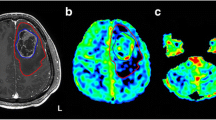Abstract
Introduction
Dyke–Davidoff–Masson Syndrome (DDMS) is a clinical syndrome that causes different clinical symptoms and is defined by volume decrement in one cerebral hemisphere. In this study, we aimed to evaluate the involvement of the normal-appearing contralateral hemisphere in 16 pediatric patients with DDMS using diffusion-weighted imaging (DWI).
Materials and methods
Brain MRIs were retrospectively reviewed between January 2014 and January 2023. Sixteen pediatric patients radiologically compatible with DDMS were included in the study. Sixteen children who had undergone brain MRI, most commonly for headaches and whose MRI findings had been completely normal, were included as the control group. Apparent diffusion coefficient (ADC) values of the deep gray and white matter of the normal-appearing hemisphere in the patient group were calculated and compared with that of the control group.
Results
The ADC values of the gray and white matters of the patient and control groups were not statistically different. However, in the patient group, the ADC values of the gray and white matters in males were remarkably lower than in females (p = 0.038, p = 0.037, respectively).
Conclusion
The difference in the ADC values of the contralateral hemisphere between females and males in the patient group suggests that the normal-appearing hemisphere may have been affected by DDMS. Although, the exact mechanism of this effect is not known. Therefore, in patients with DDMS, contralateral hemisphere involvement in cerebral hemiatrophy and hemispherectomy should be evaluated clinically and radiologically.


Similar content being viewed by others
Data availability
The datasets used and analyzed during the present study are obtainable from the corresponding author upon rational demand.
Abbreviations
- ACA:
-
Anterior cerebral artery
- ADC:
-
Apparent diffusion coefficient
- DWI:
-
Diffusion weighted imaging
- DDMS:
-
Dyke–Davidoff–Masson syndrome
- MCA:
-
Middle cerebral artery
- MRI:
-
Magnetic resonance imaging
- PSA:
-
Posterior cerebral artery
References
Tan AP, Wong YLJ, Lin BJ, Yong HRC, Mankad K (2018) Clinico-radiological approach to cerebral hemiatrophy. Childs Nerv Syst 34:2377–2390
Atalar MH, Icagasioglu D, Tas F (2007) Cerebral hemiatrophy (Dyke–Davidoff–Masson syndrome) in childhood: clinicoradiological analysis of 19 cases. Pediatr Int 49:70–75
Gökçe E, Beyhan M, Sade R (2017) Radiological imaging findings of Dyke–Davidoff–Masson syndrome. Acta Neurol Belg 117:885–893
Drake-Pérez M, Boto J, Fitsiori A, Lovblad K, Vargas MI (2018) Clinical applications of diffusion weighted imaging in neuroradiology. Insights Imaging 9:535–547
Dyke CG, Davidoff LM, Masson CB (1933) Cerebral hemiatrophy with homolateral hypertrophy of the skull and sinuses. Surg Gynecol Obstet 57:588–600
Tasdemir HA, Incesu L, Yazicioglu AK, Belet U, Gungor L (2002) Dyke–Davidoff–Masson syndrome. Clin Imaging 26:13–17
Behera MR, Patnaik S, Mohanty AK (2012) Dyke–Davidoff–Masson syndrome. J Neurosci Rural Pract 3:411–413
Aneja J, Jangli S, Singh M, Mittal A (2015) Acquired Dyke–Davidoff–Masson syndrome (DDMS). Int J Adv Med Health Res 2:55–58
Uduma FU, Emejulu JK, Motah M, Okere PC, Ongolo PC, Muna W (2013) Differential diagnoses of cerebral hemiatrophy in childhood: a review of literatur with illustrative report of two cases. Glob J Health Sci 5:195–207
Piro E, Piccione M, Marrone G, Giuffre M, Corsello G (2013) Dyke–Davidoff–Masson syndrome: case report of fetal unilateral ventriculomegaly and hypoplastic left middle cerebral artery. Ital J Pediatr 14:32
Zamora CA, Kontzialis M (2015) Teaching neuroimages: Dyke–Davidoff–Masson in Sturge–Weber syndrome. Neurology 85:e128
Bekci T, Bilgici MC, Turgut E, Aslan K (2016) A rare combination: Sturge–Weber syndrome and accompanying Dyke-Davidoff–Masson syndrome. Acta Neurol Belg 116:79–81
Corey SA, O’Donovan CA (2005) Sturge–Weber syndrome and accompanying Dyke–Davidoff–Masson syndrome. Arch Neurol 62(12):1928–1929
Gaillard F, Yap J, Fortin F et al (2023) Sturge-Weber syndrome. Reference article, Radiopaedia.org. https://doi.org/10.53347/rID-8210. Accessed 19 Nov 2023
Öztoprak B, Öztoprak İ, Bozkurt H, Çiğdem B, Yıldız ÖK (2016) A DWI study of the contralateral hemisphere in cerebral hemiatrophy. J Neurol Sci 363:253–257
Koliatsos VE, Alexandris AS (2019) Wallerian degeneration as a therapeutic target in traumatic brain injury. Curr Opin Neurol 32:786–795
Wakamoto H, Eluvathingal TJ, Makki M, Juhász C, Chugani HT (2006) Diffusion tensor imaging of the corticospinal tract following cerebral hemispherectomy. J Child Neurol 21:566–571
Xin J, Zhang Y, Tang Y, Yang Y (2019) Brain differences between men and women: evidence from deep learning. Front Neurosci 8:185
Adamson MM, Main K, Harris OA, Kang X (2022) Sex differences in cortical thickness and diffusion properties in patients with traumatic brain injury: a pilot study. Brain Inj 21:488–502
Keçeli AM (2021) Diffusion changes in cerebral white matter: the effect of age and gender. Hitit Med J 3:63–70
Lebel C, Treit S, Beaulieu C (2019) A review of diffusion MRI of typical white matter development from early childhood to young adulthood. NMR Biomed 32:e3778
Funding
This study did not receive any funding or financial support.
Author information
Authors and Affiliations
Corresponding author
Ethics declarations
Conflict of interest
The authors declare no competing interests.
Additional information
Publisher's Note
Springer Nature remains neutral with regard to jurisdictional claims in published maps and institutional affiliations.
Rights and permissions
Springer Nature or its licensor (e.g. a society or other partner) holds exclusive rights to this article under a publishing agreement with the author(s) or other rightsholder(s); author self-archiving of the accepted manuscript version of this article is solely governed by the terms of such publishing agreement and applicable law.
About this article
Cite this article
Gul, E., Atalar, M.H. & Atik, I. Evaluation of the contralateral hemisphere with DWI in pediatric patients with Dyke–Davidoff–Masson syndrome. Acta Neurol Belg (2024). https://doi.org/10.1007/s13760-024-02473-5
Received:
Accepted:
Published:
DOI: https://doi.org/10.1007/s13760-024-02473-5




